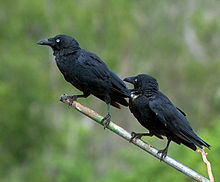Torresian crow
| Torresian crow | |
|---|---|
 |
|
| Scientific classification | |
| Kingdom: | Animalia |
| Phylum: | Chordata |
| Class: | Aves |
| Order: | Passeriformes |
| Family: | Corvidae |
| Genus: | Corvus |
| Species: | C. orru |
| Binomial name | |
|
Corvus orru Bonaparte, 1850 |
|
 |
|
The Torresian crow (Corvus orru), also called the Australian crow or Papuan crow, is a passerine bird in the crow family native to the north and west of Australia and nearby islands in Indonesia and Papua New Guinea. The species has an all-black plumage, beak and mouth with white irises. The Torresian Crow is slightly larger with a more robust bill than the morphologically similar little crow.
The Torresian crow was described by the French ornithologist Charles Lucien Bonaparte in 1850. The origin of the specific epithet orru is not known but may be derived from a Papuan name.
There are three subspecies:
The Bismarck crow (Corvus insularis) on the Bismarck Archipelago was formerly considered a subspecies. In Central Australia southwest of Alice Springs, the Pitjantjatjara term for race ceciliae is kaanka. The term wati kaanka refers to a light-fingered man or someone who hangs around suspiciously.
The Torresian crow is a large corvid, about the same size (48–53 cm in length) as the Eurasian carrion crow but with a more robust bill and slightly longer legs. The plumage of the Torresian Crow is glossy black on the back and dull black on the breast with inconspicuous throat hackles. Its tail is broad and has a distinctive square-shaped tip. Its bill is dark grey and about the same length as the head. The legs and feet are a similar dark grey color with pink foot soles. The Torresian crow has the typical white iris of the other Australasian Corvus species with a fine, blue eye-ring. However, it can be distinguished from most except the little crow by the base of the head and neck feathers being white. The white feather bases are revealed when ruffled. Birds of this species characteristically shuffle their wings after alighting. Sexes are identical in their appearance, however juveniles lack glossy dorsal feathers and have brown eyes, rather than white, up to about nine months of age.
...
Wikipedia

